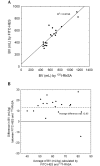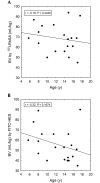Measurement of Blood Volume in Adult Rhesus Macaques (Macaca mulatta)
- PMID: 26632777
- PMCID: PMC4671783
Measurement of Blood Volume in Adult Rhesus Macaques (Macaca mulatta)
Abstract
Most biomedical facilities that use rhesus macaques (Macaca mulatta) limit the amount of blood that may be collected for experimental purposes. These limits typically are expressed as a percentage of blood volume (BV), estimated by using a fixed ratio of blood (mL) per body weight (kg). BV estimation ratios vary widely among facilities and typically do not factor in variables known to influence BV in humans: sex, age, and body condition. We used indicator dilution methodology to determine the BV of 20 adult rhesus macaques (10 male, 10 female) that varied widely in body condition. We measured body composition by using dual-energy X-ray absorptiometry, weight, crown-to-rump length, and body condition score. Two indicators, FITC-labeled hydroxyethyl starch (FITC-HES) and radioiodinated rhesus serum albumin ((125)I-RhSA), were injected simultaneously, followed by serial blood collection. Plasma volume at time 0 was determined by linear regression. BV was calculated from the plasma volume and Hct. We found that BV calculated by using FITC-HES was consistently lower than BV calculated by using (125)I-RhSA. Sex and age did not significantly affect BV. Percentage body fat was significantly associated with BV. Subjects categorized as having 'optimal' body condition score had 18% body fat and 62.1 mL/kg BV (by FITC-HES; 74.5 mL/kg by (125)I-RhSA). Each 1% increase in body fat corresponded to approximately 1 mL/kg decrease in BV. Body condition score correlated with the body fat percentage (R(2) = 0.7469). We provide an equation for calculating BV from weight and body condition score.
Figures







References
-
- Anomymous 1980. Recommended methods for measurement of red-cell and plasma volume: International Committee for Standardization in Haematology. J Nucl Med 21:793–800. - PubMed
-
- Ageyama N, Shibata H, Narita H, Hanari K, Kohno A, Ono F, Yoshikawa Y, Terao K. 2001. Specific gravity of whole blood in cynomolgus monkeys (Macaca fascicularis), squirrel monkeys (Saimiri sciureus), and tamarins (Saguinus labiatus) and total blood volume in cynomolgus monkeys. Contemp Top Lab Anim Sci 40:33–35. - PubMed
-
- Bender MA. 1955. Blood volume of the rhesus monkey. Science 122:156. - PubMed
-
- Clingerman KJ, Summers L. 2005. Development of a body condition scoring system for nonhuman primates using Macaca mulatta as a model. Lab Anim (NY) 34:31–36. - PubMed
-
- Davy KP, Seals DR. 1994. Total blood volume in healthy young and older men. J Appl Physiol 76:2059–2062. - PubMed
Publication types
MeSH terms
Substances
Grants and funding
LinkOut - more resources
Full Text Sources
